Winter Tree Planting In The Bay Area
Image by Freepik
Introduction
In the bustling urban landscape of San Francisco, the role of tree planting emerges as a crucial element in fostering a sustainable and vibrant environment. At Arborist Now , we are dedicated to enhancing the green spaces of the Bay Area, recognizing the myriad benefits trees bring to our community. This blog post explores the significance of tree planting, particularly in the unique climate of the Bay Area, and highlights the collective responsibility we share in nurturing a greener future.
The Importance of Tree Planting in the Winter
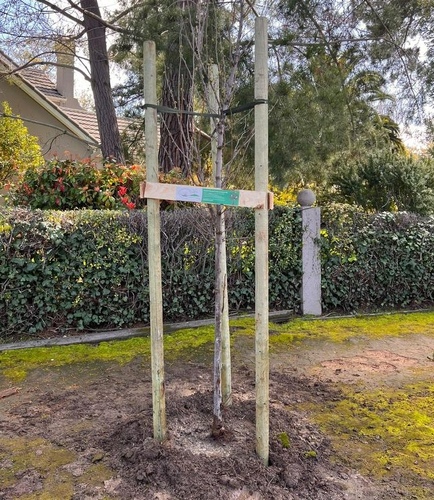
Newly planted tree, San Francisco, CA
Tree planting is a powerful tool in combating environmental degradation and climate change. Trees act as natural carbon sinks, absorbing carbon dioxide and other greenhouse gases, thereby mitigating global warming.
Beyond their environmental impact, trees enhance biodiversity, support soil health, prevent erosion, and offer aesthetic and recreational values. The socioeconomic benefits of tree planting are also significant, including job creation in tree planting and maintenance, and potential income from fruit and timber production.
Climate Considerations for Winter Tree Planting in the Bay Area
The Bay Area’s mild winter climate is uniquely suited for tree planting. The cooler temperatures and frequent rainfall provide ideal conditions for tree root establishment, allowing trees to develop strong root systems before the onset of warmer, drier months.
This climate also minimizes the risk of frost damage and root damage from freeze-thaw cycles, setting the stage for vigorous tree growth and survival.
Benefits of Winter Tree Planting
Water Conservation and Resource Efficiency
Winter tree planting optimizes water use efficiency by capitalizing on seasonal rainfall patterns and reducing reliance on supplemental irrigation. During the rainy season, trees benefit from natural precipitation, minimizing the need for artificial watering and conserving precious freshwater resources .
By aligning tree-planting efforts with natural hydrological cycles, communities enhance water security, mitigate urban runoff, and promote ecosystem resilience. Additionally, winter-planted trees contribute to groundwater recharge and soil moisture retention, supporting sustainable agriculture and ecosystem health in the long term.
Enhanced Drought Resilience and Climate Adaptation
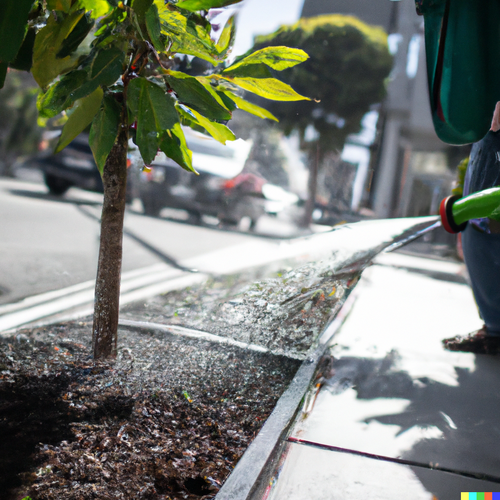
Watering newly planted trees
Winter-planted trees develop resilient root systems that enable them to withstand periods of drought and water scarcity more effectively. By establishing robust root networks during the wet season, trees can access deeper soil moisture reserves and survive prolonged dry spells with minimal stress.
This enhanced drought resilience reduces the vulnerability of urban forests to climate change impacts, such as heat waves, droughts, and water restrictions. Furthermore, winter tree planting supports climate adaptation efforts by increasing the overall resilience of ecosystems, mitigating heat island effects, and enhancing biodiversity.
Improved Air Quality and Public Health
Trees planted during the winter months play a vital role in improving air quality and safeguarding public health in urban areas. By absorbing air pollutants, such as particulate matter, ozone, and nitrogen dioxide, trees help purify the atmosphere and reduce the risk of respiratory illnesses and cardiovascular diseases.
Winter-planted trees mitigate the adverse effects of urban air pollution, enhance urban livability, and create healthier environments for residents and visitors alike. Moreover, by providing shade and reducing ambient temperatures, trees contribute to heat stress mitigation, energy conservation, and enhanced outdoor comfort during warmer months.
Carbon Sequestration and Climate Change Mitigation
Winter-planted trees serve as valuable allies in the fight against climate change by sequestering carbon dioxide from the atmosphere and storing it in their biomass. Through photosynthesis, trees capture CO2 and convert it into organic matter, locking away carbon for years to come.
This carbon sequestration process helps mitigate the greenhouse effect, reduce carbon emissions, and offset the impacts of fossil fuel combustion. By expanding urban tree cover through winter planting initiatives, communities can enhance their carbon sink capacity, support climate mitigation efforts, and contribute to global carbon balance restoration.
Socioeconomic Advantages of Tree Planting
Job Creation and Economic Growth
Tree planting and maintenance initiatives offer opportunities for job creation and economic growth within local communities. By investing in tree-planting projects, municipalities stimulate employment in various sectors, including landscaping, arboriculture, and urban forestry.
These green jobs not only provide stable employment opportunities but also contribute to the overall economic vitality of the region. Additionally, tree planting projects may create opportunities for workforce development and training programs, equipping individuals with valuable skills for careers in environmental stewardship and horticulture.
Income Diversification and Sustainable Livelihoods
Trees provide a renewable source of income through the production of fruits, nuts, and timber products. By cultivating orchards and agroforestry systems, communities can diversify their income streams and promote sustainable livelihoods for residents.
The sale of tree products generates revenue that can support community development initiatives, infrastructure projects, and environmental conservation efforts. Furthermore, tree-based enterprises contribute to food security, economic resilience, and poverty alleviation, empowering communities to thrive in harmony with their natural surroundings.
Social Equity and Community Engagement
Tree-planting projects have the potential to foster social equity and community cohesion by providing inclusive opportunities for participation and engagement. By involving residents in tree-planting activities, communities strengthen social ties, build trust, and promote a sense of collective ownership over shared green spaces.
Participatory tree-planting initiatives empower marginalized communities, amplify diverse voices, and bridge socioeconomic divides, creating more inclusive and equitable urban environments. Furthermore, tree planting projects can serve as platforms for education, skill-building, and cultural exchange, enriching community life and fostering a sense of pride in local heritage and identity.
The Aesthetic and Economic Value of Planting Trees
Enhancing Urban Landscapes
Trees play a pivotal role in enhancing the aesthetic appeal and visual charm of urban landscapes. Their towering canopies, vibrant foliage, and seasonal blooms add layers of beauty and texture to city streets, parks, and public spaces. By softening the harsh lines of buildings and infrastructure, trees create inviting green corridors, tranquil oases, and picturesque vistas that elevate the overall quality of urban life. From iconic street trees fr aming historic boulevards to verdant parklands offering respite from the hustle and bustle, trees contribute to the character, identity, and sense of place of cities and neighborhoods.
Green Infrastructure and Urban Regeneration
Trees serve as integral components of green infrastructure, providing multifunctional benefits that support urban regeneration and revitalization efforts. Through strategic tree-planting initiatives, cities can mitigate the adverse effects of urbanization, such as air and noise pollution, heat island effects, and stormwater runoff.
Street trees, green roofs, and urban forests act as natural filters, absorbing pollutants, reducing noise levels, and improving air and water quality. Moreover, green spaces created by trees enhance property values, attract investment, and stimulate economic activity, contributing to the sustainable growth and prosperity of urban areas.
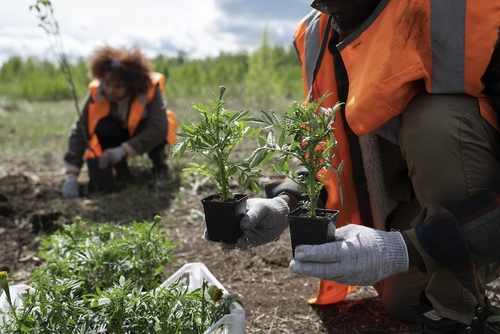
Tree Planting for Environmental Regeneration – Image by Freepik
Economic Value and Return on Investment
Trees offer substantial economic value and return on investment through various tangible and intangible benefits. From a financial perspective, trees enhance property values, boost commercial activity, and generate significant cost savings for property owners, businesses, and municipali ties.
Properties adorned with mature trees or located in tree-lined neighborhoods command higher real estate prices and attract discerning buyers seeking quality-of-life amenities. Furthermore, trees provide natural shading and cooling, reducing energy consumption for heating and air conditioning and lowering utility bills for homeowners and businesses.
By harnessing the economic potential of trees , communities can realize long-term financial gains, increase tax revenues, and stimulate economic development while simultaneously enhancing environmental sustainability and resilience.
Cultural Heritage and Sense of Place
Trees embody cultural heritage, storytelling, and collective memory, enriching the tapestry of human experience and shaping the identity of communities. Ancient trees, heritage groves, and historic arboretums serve as living monuments to the past, connecting present generations with their cultural roots and traditions. Trees featured in literature, art, and folklore evoke nostalgia, inspire creativity, and foster a sense of wonder and reverence for the natural world.
Moreover, urban trees contribute to social cohesion and community pride, serving as focal points for gatherings, celebrations, and civic events. By preserving and celebrating trees as living landmarks of cultural significance, communities can honor their shared heritage, foster intergenerational connections, and cultivate a profound sense of place and belonging.
Ecotourism and Nature-Based Recreation
Trees attract visitors and tourists to urban destinations, offering opportunities for ecotourism , nature-based recreation, and outdoor leisure activities. Urban forests, botanical gardens, and tree-lined boulevards provide experiences that immerse visitors in nature’s beauty and biodiversity. Whether exploring tree-lined trails, bird-watching in urban parks, or enjoying picnics beneath the shade of majestic trees, visitors engage with the natural world, recharge their spirits, and forge lasting memories.
Ecotourism initiatives centered around trees generate revenue for local businesses, support conservation efforts, and raise awareness about the importance of urban forests in sustaining healthy ecosystems and biodiversity. By promoting ecotourism and nature-based recreation, communities can harness the economic potential of trees while fostering environmental stewardship and promoting sustainable tourism practices.
Winter vs. Summer Tree Planting: Maximizing Benefits Year-Round
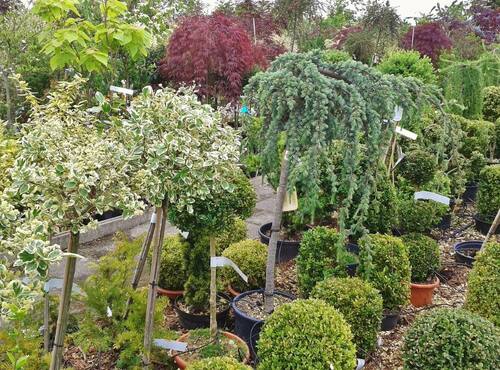
Potted Plants – Image by Cocoparisienne on Pixabay
Winter Planting: Harnessing Nature’s Rhythm
Winter tree planting offers a strategic window of opportunity to capitalize on nature’s seasonal rhythms and maximize the success of tree establishment. During the winter months, deciduous trees enter a period of dormancy, redirecting energy resources from above-ground growth to root development.
This natural cycle primes young trees for transplantation, allowing them to focus on establishing robust root systems before the demands of spring growth ensue. By planting trees in winter, tree planters can leverage this physiological advantage to promote healthier, more resilient growth and long-term survival.
Advantages of Winter Planting
- Root Development: Winter planting provides an optimal environment for root establishment, as cooler temperatures and ample soil moisture create favorable conditions for root growth. With fewer demands on above-ground foliage, trees can allocate resources toward expanding their root networks, anchoring them securely in the soil and enhancing their ability to access water and nutrients.
- Reduced Water Stress: In contrast to the parched conditions of summer, winter planting minimizes water stress on newly transplanted trees. The cooler temperatures and higher soil moisture levels mitigate the risk of drought-induced wilting and transplant shock, ensuring a smoother transition for young trees as they acclimate to their new surroundings.
- Protection from Heat Stress: Summer planting exposes young trees to the rigors of intense heat and solar radiation, increasing the risk of heat stress and sunburn damage. By opting for winter planting, tree planters shield newly transplanted trees from these environmental stressors, allowing them to establish resilient root systems without the added pressure of summer heat waves.
- Minimal Watering Requirements: Winter planting capitalizes on natural rainfall patterns, reducing the need for supplemental irrigation compared to summer planting. By harnessing seasonal precipitation, tree-planters can conserve water resources and minimize the environmental footprint of tree establishment efforts, aligning with principles of sustainable water management.
Summer Planting: Navigating Challenges
While summer planting offers its own set of advantages, including warmer temperatures and longer daylight hours conducive to above-ground growth, it also presents unique challenges that can impact tree survival and establishment. The heightened risk of heat stress, water scarcity , and transplant shock during the summer months requires meticulous planning and intensive care to ensure the success of tree planting efforts. By weighing the pros and cons of each season and adopting a strategic approach tailored to local climate conditions, tree-planters can optimize the effectiveness of their initiatives year-round.
Preparing the Tree Planting Site: Setting the Stage for Success
Soil Assessment and Amendment
Before planting trees, conducting a thorough soil assessment is crucial to ensure optimal growing conditions. Test the soil pH, texture, and nutrient levels to identify any deficiencies or imbalances. Based on the results, amend the soil as needed with organic matter, compost, or soil conditioners to improve drainage, aeration, and nutrient availability. By addressing soil health proactively, you create a fertile foundation for tree growth and vitality.
Weed Removal and Soil Preparation
Clearing the planting site of weeds and debris is essential to minimize competition for water, nutrients, and sunlight. Remove weeds by hand or with a weed wrench, taking care to remove roots to prevent regrowth. Once cleared, loosen compacted soil and create a planting bed with a gentle slope to encourage water drainage away from the tree trunk. This preparation ensures optimal root penetration and establishes favorable growing conditions for newly planted trees.
Digging Holes for Ease of Planting

Digging a Hole for a New Tree
When digging planting holes, size matters. Aim for a hole depth equal to the root ball’s height and two to three times its width to accommodate root expansion. Ensure the hole’s sides are gently sloped to prevent root circling and encourage outward growth. Prioritize digging wide rather than deep holes, as expansive root systems contribute to tree stability and long-term health. By providing ample space for root development, you lay the groundwork for robust tree establishment and growth.
Caring for Newly Planted Trees: Nurturing Growth in the First Year
Staking for Support
In windy or unstable conditions, staking newly planted trees can provide crucial support and prevent uprooting or leaning. Use flexible tree ties or straps attached to sturdy stakes driven into the ground away from the root ball. Avoid overreliance on staking, as it may hinder natural trunk movement and impede root development. Monitor tree stability regularly and remove stakes once the tree establishes firm anchorage, typically within the first year.
Watering Practices
Consistent and adequate watering is essential for the survival and establishment of newly planted trees, especially during the first year. Provide deep, slow watering sessions to penetrate the root zone and encourage downward root growth. Monitor soil moisture levels regularly, adjusting watering frequency based on weather conditions and soil moisture retention. Mulching around the base of the tree helps retain soil moisture, regulate soil temperature, and suppress weed growth, further supporting tree health and resilience.
Mulching for Moisture Retention and Weed Suppression
Applying a layer of organic mulch around the base of newly planted trees provides multiple benefits, including moisture retention, weed suppression, and soil insulation. Use materials such as wood chips, bark mulch, or compost, spreading them evenly to a depth of two to four inches around the tree’s drip line. Avoid piling mulch against the tree trunk, as this can promote moisture retention and create a favorable environment for pests and diseases. By mulching effectively, you create optimal growing conditions and reduce maintenance requirements for newly planted trees.
Pruning Considerations
Limited pruning may be necessary for newly planted trees to remove damaged or crossing branches and promote a balanced canopy structure. However, avoid excessive pruning, as it can stress the tree and impede growth. Focus on minimal corrective pruning to maintain a central leader or dominant trunk and encourage outward branching. Wait until the tree enters dormancy in late fall or early winter to perform pruning activities, allowing the tree to allocate resources toward root establishment during the growing season.
Care for Bare Root vs. Container Trees: Tailoring Maintenance Strategies
Bare Root Trees
Bare root trees require special care to prevent desiccation and promote rapid root establishment. Keep the roots moist and protected from exposure to air and sunlight during transportation and planting. Prioritize immediate planting upon receipt, ensuring the roots remain hydrated and undisturbed. Trim any damaged or excessively long roots before planting, and position the tree at the appropriate depth in the planting hole. Once planted, maintain consistent moisture levels and monitor root development closely to support successful establishment.
Container Trees
Container-grown trees offer the convenience of year-round planting and established root systems but require careful handling to prevent root circling and ensure successful transplantation. Prior to planting, inspect the root ball for circling roots, and gently tease them apart to encourage outward growth. Remove any excess soil from the root ball to expose the root flare and facilitate proper root-to-soil contact. Water container trees thoroughly before and after planting to reduce transplant shock and promote root establishment. Monitor soil moisture levels regularly and adjust watering frequency as needed to support healthy growth.
Post-Planting Practices: Sustaining Tree Health and Vigor
Monitoring Soil Moisture Levels
After planting, monitor soil moisture levels regularly to ensure adequate hydration for newly established trees. Use a soil moisture meter or conduct a manual moisture test by probing the soil with a finger to assess moisture content. Adjust watering frequency and duration based on weather conditions, soil type, and tree species’ water requirements. Avoid overwatering, as it can lead to root suffocation and fungal diseases, and prioritize deep, infrequent watering to encourage deep root growth and drought tolerance.
Inspecting for Pests and Disease
Regular inspections for pests and diseases are essential for maintaining tree health and preventing potential issues from escalating. Monitor the tree’s foliage, bark, and branches for signs of insect damage, fungal infections, or abnormal growth patterns. Look for symptoms such as wilting, yellowing leaves, abnormal leaf spots, or pest activity. If detected, promptly identify the pest or disease and implement appropriate control measures, such as pruning affected branches, applying horticultural oils or insecticidal soaps, or introducing biological controls.

Tree Care by an Arborist Now Expert
Implementing Preventative Measures
In areas prone to pest or disease pressure, implementing preventative measures can help safeguard newly planted trees against potential threats. Consider applying preventative fungicides or insecticides following planting to protect vulnerable trees during the establishment period. Choose products labeled for the target pest or disease and follow application instructions carefully to minimize environmental impact and ensure effective control.
Additionally, practice good cultural management techniques, such as proper sanitation, pruning, and plant selection, to reduce pest and disease pressure and promote overall tree health and vigor. By incorporating these post-planting practices into your maintenance routine, you can support the long-term health and vitality of newly planted trees and cultivate thriving urban forests for generations to come.
Conclusion: A Call to Action for a Greener Bay Area
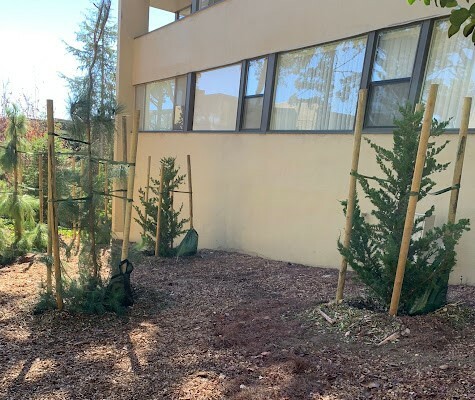
Freshly Planted and Staked Trees
Winter tree planting in the Bay Area offers a multitude of benefits, both environmental and economic. The presence of trees enhances property values, saves energy, and contributes significantly to environmental sustainability. As stewards of our environment, we have a shared responsibility to promote tree planting and urban forestry. Every tree planted is a step toward a healthier, more sustainable, and prosperous future. We encourage everyone to join us in this endeavor, be it through planting trees, participating in local conservation efforts, or supporting policies that promote urban forestry. Together, we can create a greener, more resilient Bay Area for generations to
come.


